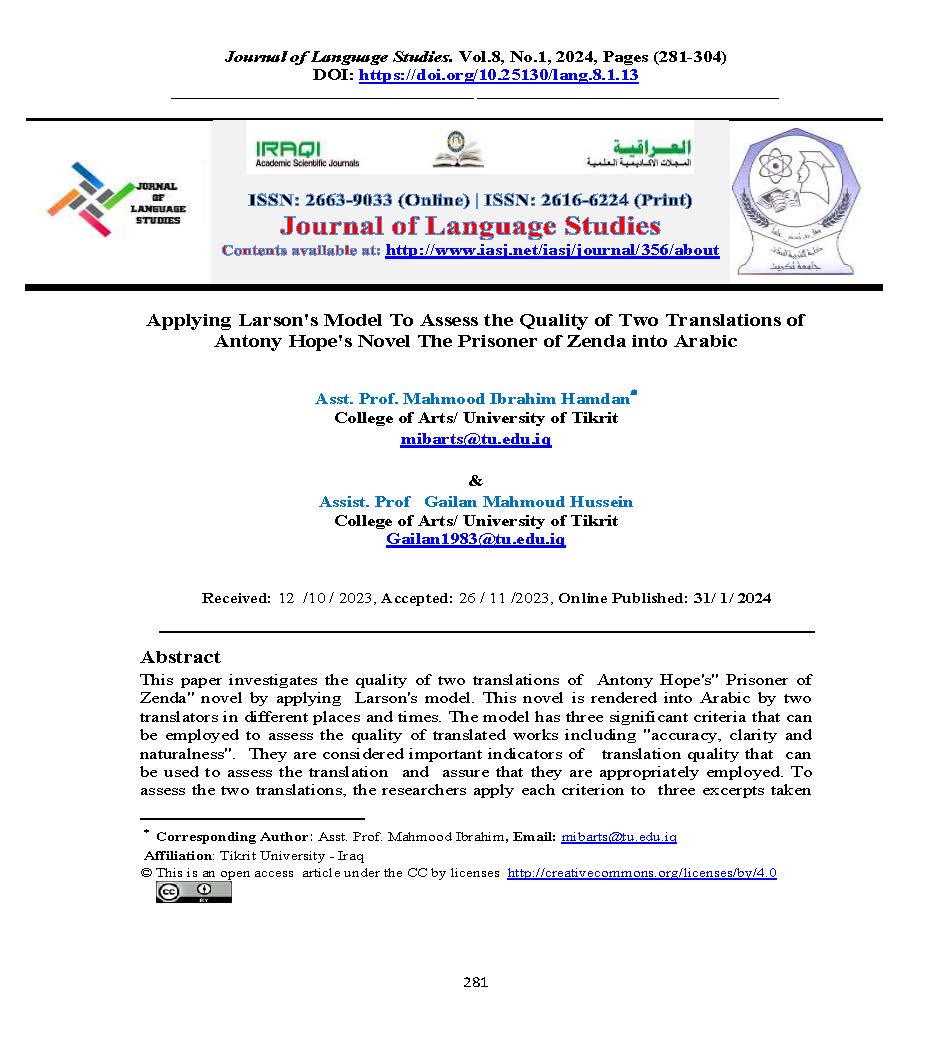Applying Larson's Model To Assess the Quality of Two Translations of Antony Hope's Novel The Prisoner of Zenda into Arabic
DOI:
https://doi.org/10.25130/lang.8.1.13Keywords:
Larson Model, criteria, Literary Translation, Assessment, QualityAbstract
This paper investigates the quality of two translations of Antony Hope's" Prisoner of Zenda" novel by applying Larson's model. This novel is rendered into Arabic by two translators in different places and times. The model has three significant criteria that can be employed to assess the quality of translated works including "accuracy, clarity and naturalness". They are considered important indicators of translation quality that can be used to assess the translation and assure that they are appropriately employed. To assess the two translations, the researchers apply each criterion to three excerpts taken from the novel and assess their translation and to what extent the source texts are appropriately rendered.
References
Al-Awawdeh, N. (2021). Translation Between Creativity and Reproducing An Equivalent Original Text. Psychology and Education Journal, 58(1), 2559-2564.
As'ad , Samiyah. (1989)."Translating a Literary Text", 'Alum Al-Fikr vol. 19 , No.4 , Kuwait.
As-Safi, A. B. (2011). Translation Theories, Strategies. Retrieved August, 25, 2014.
Aziz, Y. & Lataiwish, M. (2000). Principles of Translation. Bingazi: Dar-al-Kutub Al-Watania.
Baker, Mona.(1992) Translation and Subjectivity: The Translator's Self in Literary and Cultural Texts. Routledge.
Carter, R. (1997). Investigating English Discourse: Language, Literacy and Literature. London: Routledge and Kegan Paul.
Eyckmans, J. (2017). Cultural competence in translation studies and its assessment. In Towards transcultural awareness in translation pedagogy (pp. 209-229). LIT Verlag.
Ghazala, H. S.(2014). Creative vis-à-vis Non-creative Translation of Short Story Juxtaposed.Arab World English Journal.
Haque, M. Z. (2012). Translating literary prose: Problems and solutions. International Journal of English Linguistics, 2(6), 97.
Huang, S. (2019). A Study of the Translator’s Subjectivity in Literary Translation—Exemplified by the English Version of The Border Town. Open Journal of Social Sciences, 7(5), 99-108.
Kamalizad, J., & Khaksar, M. (2018). Translation Quality Assessment of Harry Potter and the Cursed Child according to House’TQA Model. DJ Journal of English Language and Literature, 3(2), 11-18.
Landers, C. E. (2001). Literary translation. In Literary Translation. Multilingual Matters.
Larson, M. L. (1984). Meaning based translation. Lanham, MD: University press of America.
Lefevere, A. (1992). Translation, Rewriting, and the Manipulation of Literary Fame. London: Routledge.
Muslat, A. W. M. (2012). Translation and the characteristics of literary text. Arab World English Journal, 3(1), 42-49.
Nababan, M. (2012). Pengembangan Model Penilaian Kualitas Terjemahan. Kajian Linguistik Dan Sastra, 24(1), 39–57.
Newmark, P. (1988). Pragmatic translation and literalism. TTR: traduction, terminologie, rédaction, 1(2), 133-145.
Oktaviani, R. (2018). The Choice of Larson's Translation Strategies and the Resulted Quality of Indonesian Translation of Hyperboles in The Shrunken Head Novel. English Education Journal, 8(4), 523-529.
Pei, D. (2010). The Subjectivity of the Translator and Socio-Cultural Norms. English Language Teaching, 3(3), 29-34.
Radetič, A. (2019). Literary Translation and Interculturality. International Journal of English Literature and Social Sciences (IJELS) Vol-4, Issue-3, May-Jun.–Internetressource: https://dx. doi. org/10.22161/ijels, 4(7).
Rashidi, R., & Rad, N. F. (2021). Creativity and Literary Translation: Analyzing the Relationship between Translators’ Creativity and their Translation Quality. Journal of Language, Culture, and Translation (LCT), 4(1), 1-24.
Reiss, K. (1981). ‘Type, kind and individuality of text: Decision making in translation’, translated by Susan Kitron, in Lawrence Venuti (ed.) The Translation Studies Reader , 2nd edition (2004), London and New York: Routledge, pp. 168–79.
Shakernia, S. (2014). Study of House’s model of translation quality assessment on the short story and its translated text. Global Journal of Human-Social Science: Linguistics & Education, 14(3), 3-10.
Shoubash, S. M. (2018). Fidelity and Creativity in Literary Translation between Arabic and English. Journal of humanities and Social Sciences, 2(2).
Siregar, R. (2016). Translation quality assessment of “the 8th habit: from effectiveness to greatness by Stephen R. Covey” into Indonesian. International Journal of Language and Literature, 4(1), 228-239.
Sofyan, R., & Tarigan, B. (2019, June). Developing a holistic model of translation quality assessment. In Eleventh Conference on Applied Linguistics (CONAPLIN 2018) (pp. 266-271). Atlantis Press.
Sofyan, R., Silalahi, R., Setia, E., & Siregar, B. U. (2016). Identifying the Use of Online Resources in Doing Self-Corrections: A Study of Indonesian Student Translators. International Journal of Applied Linguistics and Translation, 2(2), 15-19.
Venuti, Lawrence, ed.(2004) The Translation Studies Reader. London: Routledge.
Wang, D. F. (1998). On the Cultural Intervention in Translating. Chinese Translators Journal, 5, 6-9.

